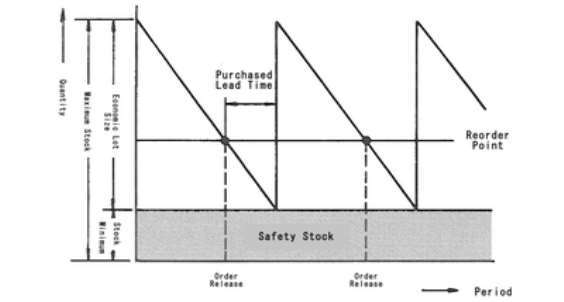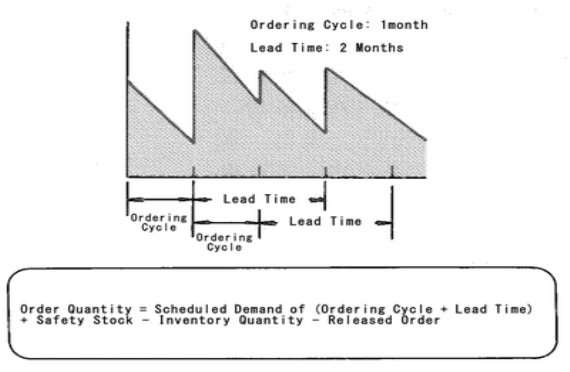The term inventory derives from the French word inventaire and the Latin word inventariom which simply means a list of things which are found. The term inventory includes materials which are in raw form, or are in process, in the finished packaging, spares and the others which are stocked in order to meet all the unexpected demands or distribution in the future. This term usually refers to the stock at hand at a particular period of time of all those materials which are in raw form, those goods which are in progress of manufacture, all the finished products, merchandise purchased products for resale of those products, tangible products which can be seen, touched, measured or are countable. In a connection with the financial statements and records of accounting, the reference may be to the amount assigned to the stock or the pile of goods owned by an enterprise at a particular period of time. Inventory controls transit and handling. The raw materials may be transported thousands of kilometers before they are converted into an end product. At the same time, materials which are in transit, may take a period of several days or months. During this process of transit, materials carry someone’s inventory. These Inventories serve to isolate the supplier, the producer and the consumer. Inventories permit the acquirement of raw materials in economic lot sizes as well as processing of these raw materials into finished goods in the most economical quantities. Raw material inventories distinguish the supplier of raw materials from the user of these raw materials. Finished goods inventories distinguish the user of the final goods from the producer of the goods. Inventories are held to facilitate product display and service to customers, batching in production in order to take advantage of longer production runs and provide flexibility in production scheduling.
The main objectives of inventory management;
- To ensure a continuous supply of raw materials and supplies to facilitate unhandled production.
- To maintain required quantity of finished goods for smooth sales operation and efficient customer service.
- It permits the acquirement of raw materials in economic lot sizes as well as processing of these raw materials into finished goods is the most economical quantity known as economic lot size.
- It reduces the dependencies of one another and enables the organizations to schedule their operations without getting dependent on each other.
- It helps to reduce those costs which have been occurred during the material handling.
- It helps to utilize people and materials reasonably.
- It controls display of the products and services provided to the corresponding customers.
Inventory System
An inventory system facilitates the organizational structure and the operating policies for maintaining and controlling materials to be inventoried. This system is responsible for ordering and receipt of materials, timing the order placement and keeping record of what has been ordered, how much ordered and from whom the order placement has been done.
There are two models of inventory system:-
- The fixed order quantity system
- The fixed order periodic system
FIXED ORDER QUANTITY SYSTEM (Q SYSTEM)
The fixed order quantity system is also known as the Q system. In this system, whenever the stock on hand reaches the reorder point, a fixed quantity of materials is ordered. The fixed quantity of material ordered each time is actually the economic order quantity. Whenever a new consignment arrives, the total stock is maintained within the maximum and the minimum limits. The fixed order quantity method is a method that facilitates for a predetermined amount of a given material to be ordered at a particular period of time. This method helps to limit reorder mistakes, conserve space for the storage of the finished goods, and block those unnecessary expenditures that would tie up funds that could be better utilized elsewhere. The fixed order quantity may be bridged to an automatic reorder point where a particular quantity of a good is ordered when stock at hand reaches a level which is already determined.
Advantages of fixed order quantity system:
- Each material can be procured in the most economical quantity.
- Purchasing and inventory control people automatically gives their attention to those items which are required only when are needed.
- Positive control can easily be handled to maintain the inventory investment at the desired level only by calculating the predetermined maximum and minimum values.
Disadvantages of fixed order quantity system:
- Sometimes, the orders are placed at the irregular time periods which may not be convenient to the producers or the suppliers of the materials.
- The items cannot be grouped and ordered at a time since the reorder points occur irregularly.
- If there is a case when the order placement time is very high, there would be two to three orders pending with the supplier each time and there is likelihood that he may supply all orders at a time.
- EOQ may give an order quantity which is much lower than the supplier minimum and there is always a probability that the order placement level for a material has been reached but not noticed in which case a stock out may occur.
- The system assumes stable usage and definite lead time. When these change significantly, a new order quantity and a new order point should be fixed, which is quite cumbersome.
FIXED ORDER PERIOD SYSTEM (P SYSTEM)
In this system, the stock position of each material of a product is checked at regular intervals of time period. When the stock level of a given product is not sufficient to sustain the operation of production until the next scheduled tested, an order is placed destroying the supply. The frequency of reviews varies from organization to organization. It also varies among products within the same organization, depending upon the importance of the product, predetermined production schedules, market conditions and so forth. The order quantities vary for different materials.
Advantages of fixed period quantity system:
- The ordering and inventory costs are low. The ordering cost is considerably reduced though follow up work for each delivery may be necessary.
- The suppliers will also offer attractive discounts as sales are guaranteed.
- The system works well for those products which exhibit an irregular or seasonal usage and whose purchases must be planned in advance on the basis of sales estimates.
Disadvantages of fixed period quantity system:
- The periodic testing system tends to peak the purchasing work around the review dates.
- The system demands the establishment of rather inflexible order quantities in the interest of administrative efficiency.
- It compels a periodic review of all items; this itself makes the system somewhat inefficient.
Distinction Between Q System and P System
| Point of difference | Q system | P system |
| Initiation of order | Stock on hand reaches to reorder point | Based on fixed review period and not stock level |
| Period of order | Any time when stock level reaches to reorder point | Only after the predetermined period |
| Record keeping | Continuously each time a withdrawal or addition is made | Only at the review period |
| Order quantity | Constant the same quantity ordered each time | Quantity of order varies each time order is placed |
| Size of inventory | less than the P system | Larger than the Q system |
| Time to maintain | Higher due to perpetual record keeping | Less than due to only at the review period |

